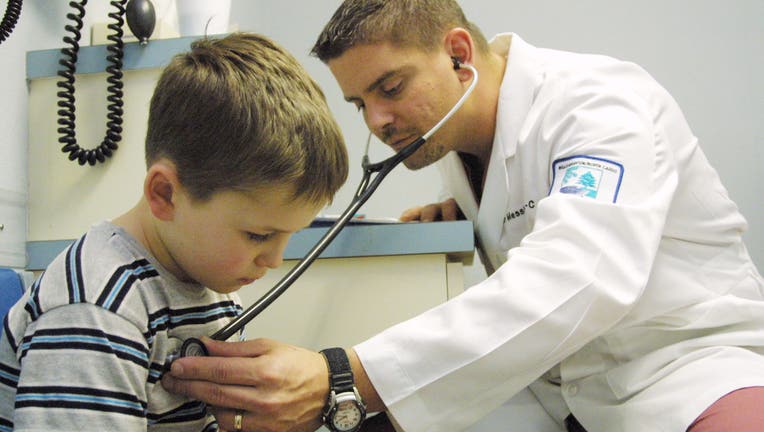'Walking pneumonia' cases on the rise in young children: What to know

FILE - A doctor in Louisiana checks a childs lungs for infection. (Photo by Mario Villafuerte/Getty Images)
The U.S. Centers for Disease Control and Prevention is tracking a notable rise in "walking pneumonia" and acute bronchitis cases in young children.
According to the CDC, respiratory infections caused by the bacteria Mycoplasma pneumoniae have increased in the U.S. over the past six months, particularly among young children. In previous years, most pneumonia or acute bronchitis infections caused by the bacteria were found in school-aged children and teens.
The infections appear to have peaked in late August. A CDC spokesperson told CBS News that the highest rates of infection are in two regions in the middle of the country, from Texas through Iowa. Other states are sounding the alarm, too, including Wisconsin and Illinois.
READ MORE: Florida reports spike in flesh-eating bacteria cases following recent hurricanes
What is Mycoplasma pneumoniae?
Mycoplasma is a bacterium that can infect different parts of the body. M. pneumoniae is a type of Mycoplasma bacteria that can damage the lining of the respiratory tract, including the throat, windpipe and lungs.
RELATED: Whooping cough cases up more than 340% over this time last year
M. pneumoniae is a common cause of mild respiratory illness, the CDC says. The most common type of infection from the bacteria is tracheobronchitis, better known as a chest cold.
"While uncommon, serious complications from infection can occur that require hospital care, including new or worsening asthma, severe pneumonia, and encephalitis," the CDC says.
M. pneumoniae bacteria are spread by inhaling respiratory droplets from an infected person’s coughs or sneezes. Handwashing and covering coughs and sneezes are effective ways to prevent the spread.
Outbreaks occur mostly in crowded environments such as schools, college residence halls, and nursing homes, the CDC says. Outbreaks can be prolonged due to:
- the long incubation period of M. pneumoniae, which is between one and four week
- the ability of the bacteria to persist in the respiratory tract for several months
- the prolonged presence of symptoms such as coughing
Children younger than 5 years old who get M. pneumoniae infection often present the following cold-like symptoms, the CDC says:
- Sneezing
- Stuffy or runny nose
- Sore throat
- Watery eyes
- Wheezing
- Vomiting or diarrhea
What is walking pneumonia?
When an M. pneumoniae infection progresses to pneumonia, it's typically a less severe form of bacterial pneumonia commonly referred to as "walking pneumonia."
According to the American Lung Association, walking pneumonia is a nonmedical term for a milder case of pneumonia.
"But don't be fooled. Walking pneumonia can still be miserable and is commonly accompanied by a cough, fever, chest pain, mild chills, headache, etc," the American Lung Association says. "It feels more akin to a bad cold, and despite what the term ‘walking’ implies, taking care of yourself is the best path to recovery."
Most people start to feel better within three to five days, but a cough from pneumonia can last weeks or months after treatment, the ALA says.
According to the CDC, macrolides, a class of antibiotics, are the first line of treatment for M. pneumoniae – the infection is resistant to other common antibiotics like penicillin.

